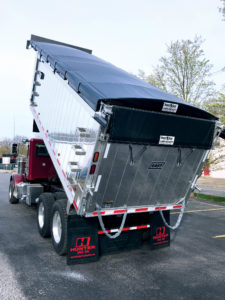
Fabric truck covers, side curtains and tarping systems are enjoying increased attention from an industry looking for advanced solutions to help keep fleets rolling along more efficiently, safely and economically. Several factors are fueling this interest. For one thing, drivers are getting older, says Vincent Merlot Jr., CEO/owner of Merlot Vango® Tarping Solutions Inc., a Verona, Pa., manufacturer and installer of tarping systems for the trucking and transportation industries.
“There aren’t enough younger folks entering the field, which is creating a shortage of drivers,” he says. “An electronically operated, rolling tarp system, which requires no manual labor, extends a driver’s career, allowing him to function longer in this capacity. And since it’s controlled from inside the cab, there is no need to climb onto the truck body to tarp the load, making it safer for drivers as well.”
Pete Johnson, co-owner and vice president/general manager of Roland Curtains Inc., says trucking industry customers do come to them asking what they can do to make it easier on drivers. Located in Arlington, Texas, the company provides custom-engineered side curtains and graphics to fleets throughout North, South and Central America. Driver safety and retention aren’t the only concerns behind the demand for fabric covering solutions, says Johnson; achieving better fuel economy is another one.
Consider the difference between hard-sided and soft-sided trailers. The former offers far less flexibility in terms of unloading the trailers, he says. For example, in a hard-sided trailer the first load in has to be the last load out, which can affect the delivery route. Instead of plotting the most fuel-efficient route, drivers must take loading/unloading into account instead, which may result in a greater expenditure of time, fuel
and money.
“But in a soft-sided trailer, the load can be taken off at any point, enabling drivers to plan the route based on the fewest miles possible, thus saving time and increasing fuel efficiency,” Johnson says. “Additionally, if hauling a load long distance, curtainside trailers allow for more backhaul options, also leading to greater fuel efficiency on the miles because the driver isn’t coming back with an empty trailer.”
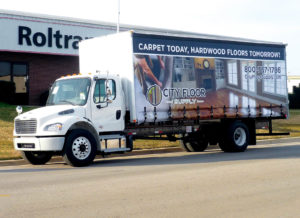
Hard-sided trailers must be dock-loaded and therefore lack the flexibility to accept any size or shape of load. However, the side-loaded curtainside trailers can accept many different kinds of loads, providing more opportunities for backhauling.
Also contributing to the use of fabric covering solutions is the building industry and the economy, says Rob Ennis, general manager and co-owner of Acadian Industrial Textiles, a wholesale distributor of industrial fabrics. Headquartered in Raleigh, N.C., Acadian works with textile mills throughout the United States and around the world, serving the agricultural, industrial, recreational and composites markets. In addition to truck covers, applications for the company’s fabrics include crop and animal shade, insect exclusion netting, paintball netting, tennis windscreens and flow media for the composites industry.
“Construction requires deliveries of supplies and removal. And as more goods are moved across the country, more tarps are used to cover many of the goods,” he says, explaining how both building and economic health affect demand. “The more frequently these are used, the sooner they need to be replaced.”
According to Ennis, Acadian primarily provides truck tarp manufacturers with woven polypropylene as well as some woven vinyl-coated polyester mesh fabric.
“Across all truck tarp fabric, vinyl-coated polyester is probably the most widely used,” he says. “The supply of these types of fabrics is well-defined and very mature. There are one or two full-line U.S. manufacturers and many importers bringing in Asian goods. Acadian focuses more on applications better suited for woven polypropylene mesh-type fabrics. These include trash and debris hauling in dump trucks and transport of dumpsters.”
Fabric and application
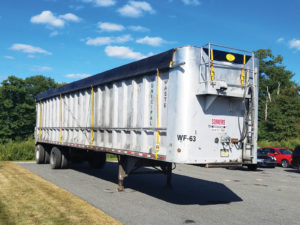
Tyler Birden, product manager for Roll-Rite® LLC (he was formerly with Automatic Load Cover LLC; the company was acquired by Roll-Rite in April 2016) also feels the economy is improving, contributing to the steady demand for his company’s products. Headquartered in Gladwin, Mich., Roll-Rite manufactures and distributes electric, hydraulic and manual tarp systems. End users include the waste/recycling, municipal, agricultural and construction markets. The company also manufactures replacement tarps for all makes and models of tarp systems and applications.
“The 79300 is our most popular one,” says Birden. “This is the ALC 300 series. It’s an automatic, fully adjustable model for multiple-axle roll-off/hook-lift trucks. We use an HD [heavy-duty] mesh tarp—1000 denier, 191/2 ounces. This material has excellent tear resistance as well as great wear resistance. We also use this material as a base and add 22-ounce vinyl to different wear areas of the tarp to make it last longer.”
The company also offers 11 x 11 1000 denier mesh, which is lighter and used for trampoline material and hand tarps. “Some customers just want to buy hand tarps and don’t want to spend money on an automatic system,” says Birden. This is a very tight and light weave, but strong, he says, and is used for covering trailers such as municipal trucks and on side-by-side systems.
Deroche Canvas, headquartered in Belvidere, N.J., specializes in custom and standard industrial tarps and tarping systems for the transportation industry, says Kevin Gulick, vice president of operations.

“We manufacture many different types of tarps, using a variety of materials,” he says. “Some of our best-selling products include lumber tarps, which are commonly made out of vinyl materials of different weights, from 14 ounces to 22 ounces, and we include a lightweight version that uses an airbag material for areas of the tarp receiving less abuse. You will see these heavy-duty tarps on flatbed trucks. We do experience many requests from women in the industry for the lumber tarps made with the airbag sides due to their lighter weight, making them easier to handle.”
These tarps are manufactured with sides lined at various heights with seatbelt webbing, a strong material to which they fasten steel D-rings that bungees or ratchets can be attached to, allowing drivers to secure the load, says Gulick. The company also makes tarps for covering dump truck loads, constructed from different kinds of meshes, such as Leno, PVC and trampoline, available in a range of weights. They can be manually deployed or the company can install an electric system that allows for load covering by way of a motor and long aluminum arms that pull the tarp across the top of the trailer.
“Deroche Canvas carries and manufactures a lot of other tarps and even debris chutes [used to remove debris from unusually high locations to a trailer or dumpster] and visual barriers [used on construction sites for security and privacy],” says Gulick. “We also offer custom tarp manufacturing for customers if their needs require unusual measurements or materials.”
Roland provides products allowing for side access to large and small fleets carrying items like lumber, building materials, paper products, steel, automobiles, glass and other materials. Included in the company’s lineup are standard curtains—the most common is the RolaFreight, the interior of which is equipped with a network of horizontal and vertical welded, PVC-coated reinforcement bands for
added strength and extra protection—and curtainside trailers like the RolaBow and the RolaLoad. The company also does specialty projects and curtainside conversions and offers hardware.
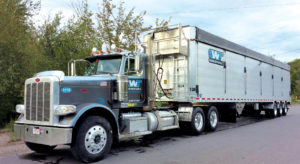
The RolaLoad, designed for flatbed trailers, is available as a complete trailer or as a covering system/upper structure alone that can be installed on a flatbed. (Seventy-five percent of the RolaLoads go out as a complete trailer; 25 percent are installed as an upper structure on a customer’s furnished flatbed.) The fabric used is a 900-gram-per-meter squared, 2 by 2 Panama weave PVC, says Johnson, adding that the curtainside trailer offers an easy, fast, efficient and driver-friendly way to protect loads—primary reasons this product is experiencing good demand.
Merlot Vango’s end users include trailer manufacturers, owner/operators, trucking companies, steel distribution centers, aluminum extrusion companies, lumber/building materials distribution companies and other businesses—essentially any company using flatbed and dump trailers, says Merlot. Solid vinyl-coated and mesh nylon fabrics solutions are offered. The company, which offers a variety of tarping solutions and panelized tarping systems, is seeing the most demand for its Vango Rolling Tarp System—engineered for one-person operation and designed to turn a flatbed into a fully enclosed trailer that can be loaded from the side, top or rear—as well as Smart Tarps and Panel Tarps, electronically operated systems for dump bodies and trailers.
“When tarps get damaged, panelized tarps are easier, faster and less expensive to repair,” says Merlot. “You only need to replace a single panel versus replacing the entire tarp. There is less downtime—and downtime equals money. The sooner the truck or trailer is back in service, the sooner it’s making money for the owner.”
Market influences
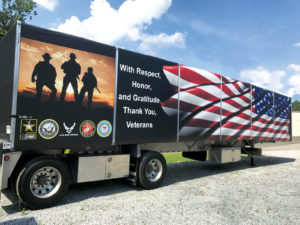
The need to attract drivers and keep them on the job longer, reduce the chance of injury, operate more efficiently and boost profitability are primary reasons many companies are embracing products like side-curtains/curtainside trailers, automatic tarping systems and manual tarps that are lighter and more easily maneuvered. But regulations also play a role, says Merlot. For example, at some customer locations, safety standards prohibit loading/unloading inside their facility unless the truck is equipped with a rolling tarp system, he says. State rules and regulations also come into play, according to Gulick.
“Each state has its own specific list of rules and regulations as far as keeping the materials truckers are hauling covered,” he explains. “This generally applies to the waste haulers and the dump trucks and trailers hauling materials that can bounce out or blow out of the body and cause damage to other vehicles.”
Pricing is another factor, says Ennis, describing the price pressure as constant. “Fabric weight, strength, abrasion resistance and price are all key to this market,” he says. “The translation of these features and characteristics into value is the calculus done by the buyers in this market. The fabric/materials decision is then combined with the value the supplier offers—product availability, responsiveness, after-sale support, etc.—to create an overall value buyers consider when making their purchasing decisions.”
Still, despite cautions about product quality and longevity, many price-sensitive users go for the cheapest option, particularly since non-custom/off-the-shelf imports are widely available, says Ennis. But these may end up costing more in the long run, he warns.
“[They] don’t provide the custom fit as when the tarp is made specifically for a particular trailer,” Ennis says. “The custom tarp will almost always last longer and perform better than an off-the-shelf, pre-made tarp. [But] the customer has to make their own value decision when choosing between low-price premade tarps versus higher-priced custom tarps.”
Pamela Mills-Senn is a freelance writer based in Long Beach, Calif.
 TEXTILES.ORG
TEXTILES.ORG


